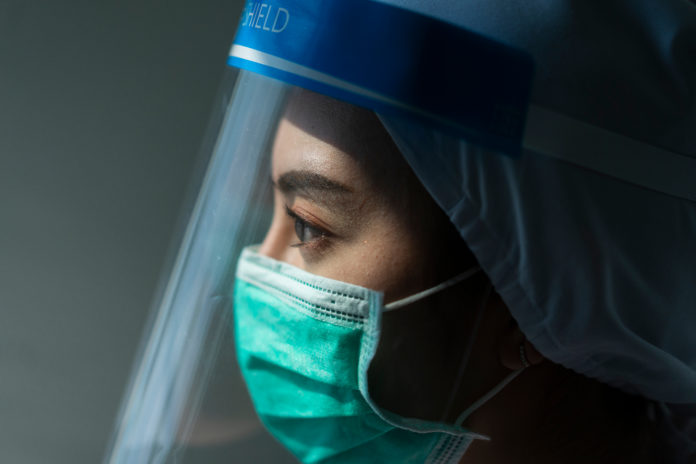By K LeBlanc, C Heerschap, B Butt, J Bresnai-Harris, L Wiesenfeld
“What do I say to a nurse in tears with a pressure injury on her nose from her PPE who is asking for a break after looking after COVID-19 patients when you are already down 3 or 4 nurses?” – Nurse Manager
In response to an overabundance calls and emails from healthcare professionals desperate for advice on how they could manage skin injury related to PPE use, Nurses Specialized in Wound, Ostomy and Continence Canada ( NSWOCC) developed a tool kit to assist healthcare professionals in the prevention and management of PPE-related skin injuries. This tool kit included a complete report, a quick reference enabler, video, and PowerPoint presentation which are available (free for download from www.nswoc.ca) to assist healthcare professionals protect and maintain tier skin integrity.
The scope of the problem
Since the onset of COVID-19 in early 2020, there has been a dramatic increase in the amount of personal protective equipment that is used on a daily basis by healthcare professionals. Since the onset of the COVID-19 pandemic, PPE skin related issues such as pressure injuries, contact dermatitis, itching, acne, and moisture related skin damage have become apparent. The longer a healthcare professional wears PPE the more skin issues present including skin irritation and skin breakdown.
One study demonstrated that out of 542 healthcare workers who experienced burning, stinging, inflammation, papules, maceration and scaling when wearing PPE, 97 per cent had prolonged use. The most commonly impacted skin areas were the nasal bridge, cheeks forehead and hands. When it comes to hands, wearing gloves long-term occludes the skin and causes a moisture imbalance. When frequent handwashing is a must, irritation, maceration and erosion as well as dermatitis can develop. Applying a protective hand cream after washing the hands and before applying PPE is recommended. Often, PPE related skin injuries are seen as minor irritations, but healthcare professionals need to take steps in order to prevent further breakdown which could result in open areas which can be portals to infection.
Key recommendations include the following:
Adequate skin care before and after the use of PPE. Application of skin barrier protectors and regular moisturizing should be carried out.
Moisturize hands regularly and ensure hands are clean and dry prior to donning gloves.
The use of dressing material as an interface should be used between the PPE and the skin in the areas of adhesion, pressure and friction. Healthcare workers must confirm with their infection control team that the dressing material used will not interfere with surgical masks. Dressing material could interfere with the efficacy of test-fitted masks.
This document also contains a table of the best practice “step-wise” approach to addressing the level of tissue damage as well as identifying dressing categories for the prevention and treatment of PPE Skin Related Damage. Strategies to reduce pressure can also be found.
PPE Toolkit
Since the use of PPE has had a dramatic increase since the onset on COVID-19. NSWOCC is providing an evidence summary for the prevention and management of PPE skin related skin injuries called Prevention & Management of Skin Damage Related to Personal Protective Equipment (PPE). Through a toolkit which is available on-line to all healthcare workers at nswoc.ca
The PPE Toolkit contains the following:
Best Practice Recommendation Document
Quick Reference Enabler
Educational Video
Teaching power point presentation
This PPE Tool Kit is intended to highlight the emerging concern of PPE-related skin injury and to provide prevention and management solutions for potential PPE related skin injury. Individuals may require a repeat mask fit testing to ensure prevention and management efforts do not interfere with PPE efficacy.
Please note that it is the responsibility of each healthcare professional to verify with their institutional infection control team that any measure taken to prevent or manage PPE-related skin injuries do not interfere with the efficacy of the PPE nor are in contravention to any workplace policy.
Kimberly Leblanc, PhD, RN, NSWOC, WOCC ( C) FCAN, Corey Heerschap, MScCH, BScN, RN, NSWOC, WOCC(C), IIWCC , Britney Butt MClSc-WH, BScN, RN, NSWOC, WOCC(C)and Julia Bresnai-Harris, BN, RN, NSWOC , TVN, all members of Nurses Specialized in Wound, Ostomy and Continence Canada, and Dr Lorne Weisenfeld, MDCM, FRCPC, worked diligently to develop a PPE Toolkit in order to assist healthcare professionals in reducing the risk of skin breakdown under PPE.


